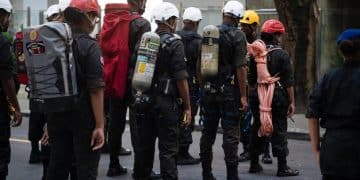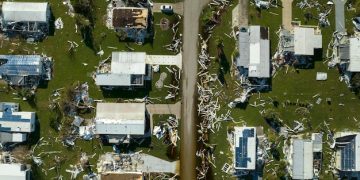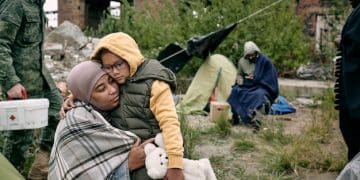FEMA vs. USAID: Key Differences in Disaster Relief for US Citizens

FEMA (Federal Emergency Management Agency) and USAID (United States Agency for International Development) are key players in disaster relief, but while FEMA focuses on domestic disasters within the US, USAID primarily addresses international crises, each with distinct mandates and operational approaches.
When disaster strikes, what are the key differences between FEMA and USAID disaster relief programs for US citizens? Understanding the roles of the Federal Emergency Management Agency (FEMA) and the United States Agency for International Development (USAID) is essential for both affected individuals and those keen on grasping the landscape of humanitarian aid.
FEMA: Domestic Disaster Response
FEMA, the Federal Emergency Management Agency, is primarily responsible for coordinating the federal government’s response to disasters within the United States. This includes natural disasters like hurricanes, floods, wildfires, and earthquakes, as well as man-made incidents.
FEMA’s main goal is to lessen the impact of disasters on people and property. They achieve this through a variety of programs and activities executed pre-disaster, during, and post disaster.
Key Responsibilities of FEMA
FEMA’s responsibilities span a wide range of activities designed to support states, local communities, and individuals affected by disasters:
- Preparedness: FEMA works with state and local governments to develop emergency plans and conduct training exercises.
- Response: FEMA coordinates federal resources during a disaster, providing assistance such as search and rescue, shelter, and medical care.
- Recovery: FEMA helps communities rebuild after a disaster through grants, loans, and other programs.
- Mitigation: FEMA provides funding and technical assistance to reduce the risk of future disasters.
FEMA plays an important role by ensuring state and local governments are equipped to handle emergencies effectively so the damage caused by disasters are mitigated.
USAID: International Humanitarian Aid
The United States Agency for International Development (USAID) is the lead federal agency responsible for foreign aid and development assistance. In the context of disaster relief, USAID responds to crises around the world, providing humanitarian assistance to countries affected by natural disasters, conflict, and other emergencies.
USAID aims to save lives, alleviate suffering, and reduce the long-term impact of disasters in developing countries. The agency partners with international organizations, non-governmental organizations (NGOs), and host governments to deliver aid effectively.

Key Responsibilities of USAID in Disaster Relief
USAID’s disaster relief efforts encompass a broad range of activities tailored to the specific needs of each crisis:
Emergency Response: USAID deploys disaster response teams to assess needs and coordinate assistance. These teams work closely with local authorities and aid organizations to ensure that aid reaches those who need it most.
Humanitarian Assistance: USAID provides essential relief supplies such as food, water, shelter, and medical care. They also support programs aimed at preventing and controlling disease outbreaks.
Recovery and Reconstruction: USAID helps communities rebuild after a disaster by supporting infrastructure projects, providing job training, and promoting economic development. These activities can include building schools and hospitals, training healthcare workers, assisting farmers, and more.
Therefore, USAID’s global approach to disaster relief helps provide resources and support to developing nations affected by natural disasters.
Geographic Scope: Domestic vs. International
One of the most significant key differences between FEMA and USAID disaster relief programs for US citizens lies in their geographic focus.
FEMA is responsible for disaster response within the United States and its territories. This includes all 50 states, as well as the District of Columbia, Puerto Rico, the U.S. Virgin Islands, Guam, and other territories.
In contrast, USAID operates primarily in developing countries around the world. While USAID may occasionally provide assistance to countries outside of the developing world, their primary focus is on addressing humanitarian needs in less developed nations.
Overlapping Jurisdiction
During international disasters, it is USAID that provides services. FEMA would only work within US territory, and its territories abroad.
- Domestic Focus: FEMA is dedicated to serving the US and its territories.
- International Reach: USAID is tasked with international aid and relief.
- Jurisdictional Clarity: Their roles are geographically defined.
The distinction is clear. FEMA helps at home, and USAID helps internationally, with little overlap.
Types of Assistance Provided
The types of assistance provided by FEMA and USAID also differ significantly.
FEMA provides a wide range of assistance to individuals, families, and communities affected by disasters. This includes:
- Financial Assistance: FEMA provides grants to help individuals and families with expenses such as housing, medical care, and funeral costs.
- Housing Assistance: FEMA provides temporary housing assistance, such as rental assistance or temporary housing units, to those displaced by disasters.
- Disaster Unemployment Assistance: FEMA provides unemployment benefits to individuals who have lost their jobs due to a disaster.

In comparison, USAID’s assistance typically focuses on meeting the basic needs of affected populations in developing countries:
- Food Assistance: USAID provides food aid to address hunger and malnutrition.
- Water and Sanitation: USAID supports programs to provide clean water, sanitation facilities, and hygiene education.
- Medical Care: USAID provides medical supplies, equipment, and personnel to treat the sick and injured.
FEMA and USAID adapt their approaches to meet the needs of varied populations during a crisis.
Eligibility Criteria for Assistance
To receive assistance from FEMA, individuals and households must meet certain eligibility criteria.
In general, applicants must be:
- A U.S. citizen, non-citizen national, or qualified alien.
- Residing in a designated disaster area.
- Suffered damage or loss as a result of the disaster.
FEMA also considers factors such as income, insurance coverage, and other resources available to the applicant.
USAID’s assistance is typically provided to affected populations through host governments, international organizations, and NGOs. Eligibility criteria are determined by these partner organizations based on the specific needs of the affected population.
Navigating Aid as a US Citizen Abroad
As a US citizen living or traveling abroad, support options are somewhat different than in America. USAID focuses on aid regardless of nationality within affected regions, but also US citizens will not have direct access to FEMA’s traditional programs.
Coordination and Collaboration
Both FEMA and USAID work closely with a variety of partners to coordinate disaster relief efforts.
FEMA collaborates with state and local governments, federal agencies, non-profit organizations, and the private sector. They follow the National Response Framework (NRF), a guide to how the nation responds to all types of disasters and emergencies.
USAID partners with international organizations such as the United Nations, the World Food Programme, and the World Health Organization, as well as NGOs and host governments. Such collaboration can create international support networks.
Challenges and Synergies
The two agencies can handle issues that would surpass what one agency can do alone.
- Overlapping Skills: Each agency has expertise that the other could use.
- Resource Allocation: Shared logistics and funds improve access.
- Planning: Joint planning can make responses faster.
Working together efficiently, FEMA and USAID can face issues with more collective agility.
| Key Aspect | Brief Description |
|---|---|
| 📍 Geographic Focus | FEMA assists within the US; USAID operates internationally, focusing on developing countries. |
| 💰 Types of Aid | FEMA offers financial, housing, and unemployment assistance; USAID provides food, water, sanitation, and medical care. |
| ✅ Eligibility | FEMA requires US citizenship and residence in a disaster area; USAID aid is given through partners based on need. |
| 🤝 Collaboration | FEMA works with US agencies and NGOs; USAID partners with UN, WHO, and international groups. |
Frequently Asked Questions
▼
Prioritize safety. Ensure your environment is secure, then seek medical attention if needed. Document damage for insurance and assistance claims, and contact your insurance company promptly.
▼
FEMA assesses eligibility based on citizenship, residency in a declared disaster area, and the extent of damages incurred, considering income, insurance, and available resources. A damage inspection may also take place.
▼
USAID provides essential humanitarian aid, including food, water, sanitation, medical supplies, and shelter. Aid programs focus on preventing disease outbreaks and help reconstruct essential infrastructure.
▼
FEMA primarily helps within the US and its territories. US citizens abroad would need to rely on USAID or other international aid organizations for disaster relief. Contacting the US embassy is a good first step.
▼
You can support disaster relief by donating to reputable organizations, volunteering your time, or advocating for policies that strengthen disaster preparedness and response both domestically and internationally through political channels.
Conclusion
Understanding what are the key differences between FEMA and USAID disaster relief programs for US citizens is critical for effective disaster response. FEMA ensures aid reaches US citizens within the country, while USAID extends help internationally, showcasing the US’s commitment to humanitarian aid on a global scale.





